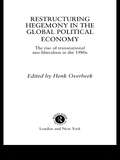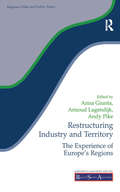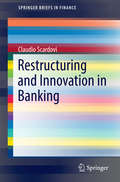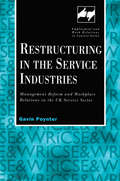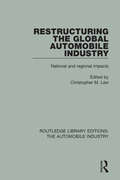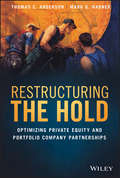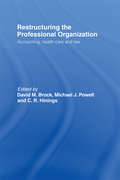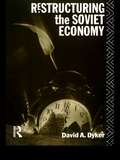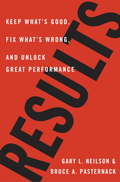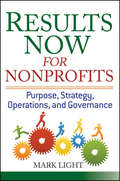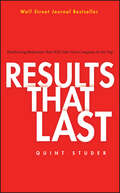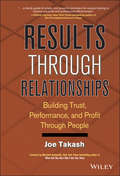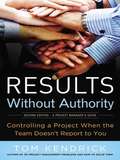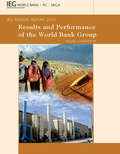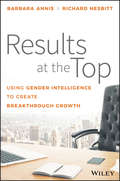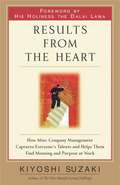- Table View
- List View
Restructuring Hegemony in the Global Political Economy: The Rise of Transnational Neo-Liberalism in the 1980s
by Henk OverbeekSince the late 1970s, the spread of Neo-liberalism and the failure of socialist economies and systems in Eastern Europe have resulted in a practically unchallenged hegemony of international capital across the globe. Neo-liberalism is now the dominant ideology, legitimizing the privatisation of state-controlled economies and the substitution of the
Restructuring Industry and Territory: The Experience of Europe's Regions (Regions and Cities #24)
by Andy Pike Arnoud Lagendijk Anna GiuntaExamining the current trends in regional economic development in Europe, Restructuring Industry and Territory explores ways in which the restructuring of industry and territorial development relate to each other, their emergent interdependency and role in economic development. The book argues that the structural and cultural features of regions play an important part in helping or hindering concerted policies for regional development. Using case studies from different industries in a variety of regions, the contributors show that the pressures for restructuring, such as internationalisation or even 'globalisation', have been mediated by formerly nationally rooted industries in Europe becoming increasingly integrated, due to the ongoing processes of technological and organisational innovation, and political regulation.
Restructuring JAL
by Nobuo Sato Malcolm P. Baker Adi Sunderam Akiko KannoHideo Seto, the recently appointed chairman of the investment committee of the Enterprise Turnaround Initiative Corporation, must decide whether to push JAL group, Japan's largest airline, into bankruptcy or to act as a sponsor in an out-of-court restructuring. The bankruptcy of JAL would be the largest ever for an industrial firm in Japan's history. The case introduces the mechanics of bankruptcy, the tradeoff between out-of-court restructuring and bankruptcy, and the costs of financial distress. At the level of public policy, the case also serves as a useful backdrop to discuss the role of bankruptcy in the efficient functioning of the economy, and the related comparison between Japan and the U.S. in terms of both the bankruptcy code and the cultural attitudes toward corporate restructuring. This case can fit into an introductory course in a module on capital structure and the tradeoff between the costs and benefits of debt or in an advanced corporate restructuring course in a module on the effect of different legal and cultural environments on bankruptcy proceedings.
Restructuring Navigator Gas Transport Plc.
by C. Fritz FoleyHow should creditors pursue their claims in a multi-jurisdiction bankruptcy? David Butters, Managing Director at Lehman Brothers, negotiates a restructuring of Navigator Gas Transport, a shipping company that is headquartered in Switzerland, incorporated in the Isle of Man, and operates ships that travel around the world. In analyzing the choices he faces, students must consider how the initial capitalization of Navigator contributed to its financial distress, evaluate several restructuring plans from a variety of perspectives, and assess how Butters might resolve the legal inconsistencies that arise in a multi-jurisdiction bankruptcy. In addition, they must determine if Butters has sufficient information about, and control over, operations at Navigator to be confident engaging in a lengthy set of legal proceedings.
Restructuring Ukraine
by Kristin Mugford Seema Amble Tian FengIn 2015, Ukraine needs IMF funding to bridge a projected $40 billion funding shortfall and is proposing a 40% "haircut" to Ukraine's $18 billion of Eurobonds. Can Ukraine negotiate a deal with its many creditors that will give it the funding the country needs on terms they can accept?
Restructuring and Innovation in Banking
by Claudio ScardoviThis book explains how to restructure and successfully turn around a bank or financial institution at a time when the global financial system is facing a new wave of disruption ushered in by innovation from digital financial technology, or FinTech. It is argued that within banking this process of creative destruction will entail unprecedented challenges for traditional institutions as well as opportunities for new, mostly digital, players. A great deal of restructuring, turnaround, and transformation will be required. While information on these topics is widely available with respect to corporates, this is not the case for banks. The book addresses this neglected area in detail, analyzing the changes that have been set in motion, examining how creative destruction can be anticipated by both old and new players, and explaining how to better manage restructuring and innovation in banking. The book will appeal to top and middle managers of banks and financial institutions, advisers, regulators, academics, and students.
Restructuring and Privatization in Central Eastern Europe: Case Studies of Firms in Transition
by Alan Gelb Inderjit Singh Joseph C. Brada Saul EstrinThis volume presents cases from a World Bank study of state-owned industrial firms in Poland, Hungary and the Czech and Slovak republics. Topics that are covered include: structure of the industry; history of the firm; and product mix and sales pattern.
Restructuring at Delphi Corporation (A)
by Stuart C. Gilson Sarah L. AbbottDelphi Corporation, operating under Chapter 11 bankruptcy protection, has filed a plan of reorganization with the court, under which a consortium of hedge funds led by Appaloosa Management will invest up to $2.6 billion in new equity. Also participating in the plan is General Motors, which as the former parent of Delphi, has agreed to fund a portion of the massive pension and retiree health care liabilities that Delphi incurred when it separated from GM in a prior spin-off. The company has also had to seek significant financial concessions from the United Auto Workers, without which it may not survive as a going concern. Greatly complicating the negotiations is the significant uncertainty surrounding the value of Delphi's business and the complexity of its capital structure.
Restructuring at Nova Chemical Corporation
by Scott P. MasonManagement of a diversified chemicals company faces two financial decisions: whether to finance a major investment in new production facilities for its rapidly expanding Environmental Products Division, and whether to sell a more slowly growing non-specialty chemicals division. the latter decision has implications for how the new investment, if it is undertaken, should be financed. Financing options available to the firm include bank borrowing, issuing convertible debt, and selling new common stock in the public market.
Restructuring in the Service Industries: Management Reform and Workplace Relations in the UK Service Sector (Routledge Studies in Employment and Work Relations in Context)
by Gavin PoynterRestructuring in the Service Industries: Management Reform and Workplace Relations in the UK Service Sector. An examination of the complex process of transformation in work organization, technology and labour and product markets that has occurred. The analysis moves between a broad appreciation of structural developments within the economies of the advanced industrial nations, and an in-depth study of enterprise and workplace. It is divided into four parts. The first part reviews the theoretical issues and debates raised by the growth of service industries and employment in the advanced industrial countries. Parts Two and Three are case studies of two service sectors - financial services and the National Health Service. Part Four relates the evidence to a broader appreciation of developments in management/workforce relations occurring in the service sector.
Restructuring of Food Retail Markets in Countries of the Global South: The Case of Emerging Supermarkets in Dhaka, Bangladesh (Handel und Internationales Marketing Retailing and International Marketing)
by Christine HobelsbergerThis explorative, primary data-based study provides findings on the first nearly two decades of the emerging supermarket industry in Bangladesh, in particular its capital city Dhaka. The objective is thereby twofold: On the one hand, the study traces the so-far development of supermarkets in Dhaka, and Bangladesh, and depicts current hindering factors to the local supermarket industry’s further development, as well as supermarket managers’ measures to tackle these challenges. On the other hand, the study explores the (potential) implications of emerging supermarkets for other food retailers on-site. To this end, the study’s focus lies on so-called wet markets (Bengali: kacha bazars) as an exemplary “traditional” food retail format. Here, the study strives for the determination of supermarkets’ competitive pressure on kacha bazars in Dhaka, and kacha bazar vendors’ corresponding (proactive) coping strategies. The study is based on theoretical and conceptional reflections on markets and market structures, the fundamentals of retail management and modern food retail, and research findings on supermarkets’ structural impact on food retail markets in other country contexts.
Restructuring the Global Automobile Industry: Global, National And Regional Impacts (Routledge Library Editions: The Automobile Industry)
by Christopher M. LawOriginally published in 1991, this book examines the spatial implications of the changes to the automobile industry at world, national and local levels. The volume brings together the work of North American, European and Japanese geographers, economists and sociologists, and includes perspectives from the components industry, the shop floor experience and local economic policy making.
Restructuring the Hold: Optimizing Private Equity and Portfolio Company Partnerships
by Thomas C. Anderson Mark G. HabnerEstablishing an effective partnership and achieving improved outcomes for investors and management teams during the hold cycle Private equity represents a productive and fast-growing asset class—building businesses, creating jobs, and providing unlimited opportunity for investors and management teams alike, particularly if they know how to work together in candid and effective partnerships. Restructuring the Hold demonstrates how investors and managers can best work together to optimize company performance and the associated rewards and opportunities for everyone, not just the investors. Through brief references to the parable of the Gramm Company, a middle market portfolio company, readers will follow the disappointments and triumphs of a management team experiencing their first hold period under private equity ownership, from the day they get purchased through the day they get sold. Restructuring the Hold provides the reader both general knowledge and more detailed better practices and frameworks relating to specific time periods during the hold. Within this book readers will find: An examination of a typical middle-market private equity hold period Guidance for newly acquired management teams on what to expect during the hold period Descriptions of better practice operating cadence between investors and management teams Examples of effective partnerships between investors and management teams Discussions of topics relevant to typical hold periods, including organizational structures, operations improvement, selling pipelines and acquisition integrations With guidance from Restructuring the Hold, private equity principals and portfolio company executives can take steps toward greater collaboration and better outcomes. Through updated practices and strong relationships, they can partner effectively to improve portfolio company performance, which will lead to better outcomes for both investors and management teams.
Restructuring the Professional Organization: Accounting, Health Care and Law
by David M. Brock Michael J. Powell C. R. HiningsIn recent years the professions have undergone radical transformation. With the advent of rapidly changing markets, more sophisticated and demanding clients, deregulation and increased competition, the generalist professional partnerships have given way to larger, more corporate forms of organization, comprising increasingly autonomous specialist business units.This volume critically examines these changes through an examination of the archetypes which characterize accounting, health care and law practitioners. With examples drawn from Australia, Canada, the UK and the USA, Restructuring the Professional Organization will be of interest to all students of organization studies seeking to understand the issues and problems confronting the professions as they move to the new millennium.Topics covered include:* a review of the models of professional organization*drivers of change in professional organizations* internal dynamics of changes in these organizations* new organizational forms and archetypes.
Restructuring the Soviet Economy
by David A. DykerRestructuring the Soviet Economy examines the Soviet leadership's most urgent question - how to revitalize the soviet economy. David Dyker argues that the current impasse can can only be understood in the context of the failure of 60 years of central planning. He analyses both the problems besetting the centrally planned system and those that have paralysed perestroika and assesses whether the most ambitious attempt ever to reform the Soviet economy will succeed.
Restructuring the U.S. Steel Industry
by William E. FruhanFocuses on the competitive decline of the integrated steel producers in the United States from 1970 to 2002. Issues include: Should the U.S. government impose tariffs to try to protect the industry? What should labor unions do, if anything, to protect jobs and wage rates of employees in failing companies?
Results
by Gary L. Neilson Bruce A. PasternackEvery company has a personality. Does yours help or hinder your results? Does it make you fit for growth? Find out by taking the quiz that's helped 50,000 people better understand their organizations at OrgDNA.com and to learn more about Organizational DNA.Just as you can understand an individual's personality, so too can you understand a company's type--what makes it tick, what's good and bad about it. Results explains why some organizations bob and weave and roll with the punches to consistently deliver on commitments and produce great results, while others can't leave their corner of the ring without tripping on their own shoelaces. Gary Neilson and Bruce Pasternack help you identify which of the seven company types you work for--and how to keep what's good and fix what's wrong. You'll feel the shock of recognition ("That's me, that's my company") as you find out whether your organization is:* Passive-Aggressive ("everyone agrees, smiles, and nods, but nothing changes"): entrenched underground resistance makes getting anything done like trying to nail Jell-O to the wall* Fits-and-Starts ("let 1,000 flowers bloom"): filled with smart people pulling in different directions* Outgrown ("the good old days meet a brave new world"): reacts slowly to market developments, since it's too hard to run new ideas up the flagpole* Overmanaged ("we're from corporate and we're here to help"): more reporting than working, as managers check on their subordinates' work so they can in turn report to their bosses* Just-in-Time ("succeeding, but by the skin of our teeth"): can turn on a dime and create real breakthroughs but also tends to burn out its best and brightest* Military Precision ("flying in formation"): executes brilliant strategies but usually does not deal well with events not in the playbook* Resilient ("as good as it gets"): flexible, forward-looking, and fun; bounces back when it hits a bump in the road and never, ever rests on its laurelsFor anyone who's ever said, "Wow, that's a great idea, but it'll never happen here" or "Whew, we pulled it off again, but I'm tired of all this sprinting," Results provides robust, practical ideas for becoming and remaining a resilient business. Also available as an eBookFrom the Hardcover edition.
Results Now
by Brian GravesAffiliate Marketing can be one of the best sources of steady income online. It just has to be put together the right way. And this product does just that.
Results Now for Nonprofits
by Mark LightBuild your nonprofit into a high performer with this practical approach to purpose, strategy, operations, and governance Planning is vital to achieving your nonprofit's purpose-too bad most nonprofits are strapped for time. Not anymore. Using a lightning-fast and inclusive process, Results Now® puts purpose, strategy, operations, and governance into one user-friendly, comprehensive plan that your board can pass in a single vote and your organization can maintain as a regular part of its business throughout the year. Results Now for Nonprofits relies on accountability and performance measurement to increase the level of effective decision-making. This "big picture first, details next" planning process helps you: Use the Results Now master plan as a centerpiece of board meetings and as a standard part of board meeting advance information Foster a welcome climate for give-and-take strategic thinking Clarify the organization's story for the community and keep people on point about what's important Develop team cohesion Orient newer leadership members and recharge seasoned ones Attract new funders who reward nonprofits who planA must-have for all nonprofit executives and directors, members of boards and trustees, and nonprofit managers, Results Now for Nonprofits is a results-driven, practical tool that will help your organization achieve its mission, values, and destiny.
Results That Last: Hardwiring Behaviors That Will Take Your Company to the Top
by Quint StuderPraise for Results That Last"Quint Studer is a superb communicator with a deep belief in the power of relationships. His informal tone, sense of humor, and real-world stories bring his business principles to life. Results That Last has a vital, optimistic quality that will keep readers re-reading long after other leadership books have been relegated to a dark corner of the shelf."--Nido Qubein, author of How to Get Anything You Want; President, High Point University; Chairman, Great Harvest Bread Company; and founder, National Speakers Association Foundation"Results That Last is long overdue and fills a big gap in effective business management. There are legions of books that show us the way to achieve successful results in business, but very few that teach us how to institutionalize success. In reality, achieving success is the easy part. The real challenge is to achieve results that last. Quint Studer not only proves it is possible to hardwire a culture for lasting results, but lays out a simple, logical, and effective way to do so. Anyone who wants to make success a habit needs to read this book."--Bob MacDonald, former CEO, Allianz Life of North America and author of Beat the System: 11 Secrets to Building an Entrepreneurial Culture in a Bureaucratic World"I have always been fascinated by how the various parts of an organization work together to achieve strategic objectives. In Results That Last, Quint Studer explores the complex subject of performance improvement in a fresh, readable, and easy-to-grasp way. By standardizing certain business practices and leader behaviors, any company in any field can create an environment that allows it to achieve and sustain long-term results."--David F. Giannetto, coauthor of The Performance Power Grid: The Proven Method to Create and Sustain Superior Organizational Performance
Results Through Relationships
by Joe TakashA career guide to more significant business results in a shorter period of timeResults Through Relationships shows professionals how to establish break-through relationships with new prospects and their existing networks, including colleagues, bosses, customers, clients, vendors, and others. Many people assume that only new contacts will help them achieve their goals, but in reality, many breakthroughs happen within existing networks. This handy career guide focuses on the bottom-line behaviors that expedite trust, improve workplace performance, and increase profit. Author Joe Takash presents a nine-step process that anyone can master, and his formula proves that we're all in the relationship business first.
Results Without Authority: Controlling a Project When the Team Doesn't Report to You
by Tom KendrickFor project managers looking to establish credibility and drive winning results, author Tom Kendrick&’s groundbreaking system provides the key to leading cross-functional, outsourced, and other types of teams through every stage of the project cycle.Results Without Authority is the definitive book on control--teaching the three principal levels of control, including project process, influence, and metrics, among other important areas. You learn the surefire way to keep projects moving forward: by relying only on these factors.The book&’s completely updated second edition includes new information on:agile methods and evolving project management tools,strategies for working with virtual teams,analytical versus &“blink&” decision processes,the use (and misuse) of social media in project environments,and the myth of multitasking.For project leaders lacking clear-cut authority, getting everyone on board--and keeping them there--can be a challenge. Whether you&’re managing small, team-level projects or major organizational initiatives, Results Without Authority is the must-have guide to getting the best outcomes for your company.
Results at the Top: Using Gender Intelligence to Create Breakthrough Growth
by Barbara Annis Richard NesbittWhat if your company could gain a greater profit share of the market simply by promoting more women into its senior management team? Sounds like a no-brainer, and despite nearly every study done in the past three decades proving companies with women leaders deliver superior performance, the number of women in the C-suites of companies all over the world is noticeably low. Results at the Top is written for the men who know the value female leaders bring to the table and need a tangible way to get them there. <p><p> Whether you're building your leadership team from scratch or trying to transform long-established norms for a competitive advantage today, the practical guidance inside wastes no space with blame for the current state of women leaders and goes straight to the immediate steps organizations can take to change it. It gives you everything you need to both create the internal systems for promoting gender diversity on every step of the career ladder and motivating employees to celebrate its shared, bottom-line benefits. <p> Up-to-date viewpoints don't confuse equal with same and go in-depth into the scientific differences between men and women that can complement each other to produce higher performing teams. Along with neurological variances, there are societal behaviors men and women need to recognize and substitute with more productive and advantageous ones. Through eye-opening research and illustrative examples from the real world, both sexes gain a deeper understanding of how we got here and the pioneering systems companies in the highest echelons of their industries are using to evolve leadership development all the way to the top.
Results from the Heart
by Kiyoshi SuzakiResults from the Heart introduces a new and helpful approach to improving job performance, improving job satisfaction, and helping organizations better respond to the rapid changes that are an inherent part of today's business environment. Mr. Suzaki recognizes that a motivated and engaged workforce should be part of any strategy to obtain and maintain competitive advantage. --Carl Stern, CEO, The Boston Consulting Group Since the publication of Frederick Taylor's The Principles of Scientific Management, managers have relied on logic to compel action. Now Kiyoshi Suzaki, one of the world's leading experts on enlarging the talents, self-esteem, and growth of the individual employee, argues that logic alone cannot move people to act. Productivity problems are inextricably linked to self-esteem, he argues, and worst of all to a prodigious waste of individual talent. But each solution is personal, Suzaki concludes, and found only within ourselves. "To find meaning and purpose at work we must use our brain," Suzaki says, "but listen to our heart." In Zenlike fashion he proposes that each of us ask ourselves a series of questions to determine the degree to which our brain is engaged with our heart. The framework around which this selfquestioning takes place is a groundbreaking concept that Suzaki calls "the mini-company." The author demonstrates how, within the larger workplace, each job is endowed with an almost spiritual meaning when each person -- at every level -- becomes president of his or her own area of responsibility. With simple diagrams, Suzaki shows how your boss becomes your banker or venture capitalist and your peers become your immediate suppliers or customers. The results are nothing short of astonishing. In Results from the Heart, Suzaki describes thousands of mini-companies he has "founded" during his worldwide consulting assignments. In most cases in which unhappy employees had previously "followed instructions like robots," there have been spectacular increases in both morale and productivity. If it is true that work is a journey, this manifesto for a more humane definition of the way we work is the roadmap.
